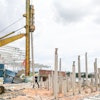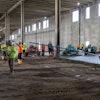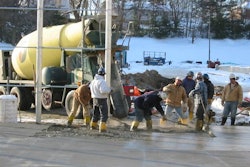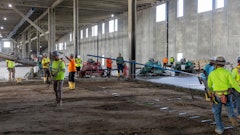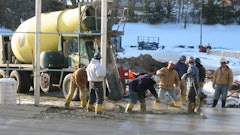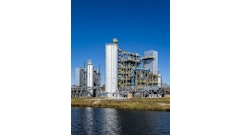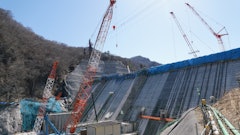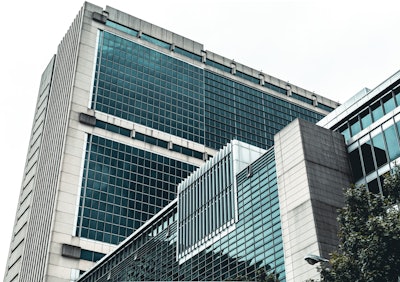
When we think of the federal government being shut down, what we commonly picture are National Parks closed, flights grounded, even delays in Social Security benefits due to staffing shortages. Rarely do we hear of how these shutdowns put a choke-hold on the legal immigration pipeline that supplies our economy with the labor vital to the industries that build America’s public infrastructure.
Every time the wheels of government stop turning, the nation’s labor pipeline to the construction industry dries up in an instant. The impact is far-reaching, not only limited to public projects that depend on federal funding. The effects ripple all the way down to the private sector too. Hiring is delayed and project timelines are suddenly extended. In the end, it worsens an already deep labor shortage that has been pushing the construction industry beyond its limits.
As this latest government shutdown drags on, many construction employers are learning a tough lesson: It’s not just money that becomes frozen in Washington. It is people; the very people they rely on to get the job done.
Shutdowns Slow the Legal Pathways to Construction Labor
While politicians debate in Congress, some functions of the government slow down behind the scenes. The department most affected is the U.S. Department of Labor (DOL). The DO plays a key role in keeping that labor pipeline open, especially employment-based immigration.
The DOL’s Office of Foreign Labor Certification (OFLC) approves labor certifications under the PERM program. These certifications serve as a first step for employers sponsoring workers through the EB-3 “Other Workers” visa program. This visa allows businesses to fill year-round positions when qualified U.S. applicants cannot be found.
When the DOL is closed because of a shutdown, PERM case processing stops. That means no certifications are being issued. Once DOL re-opens, processing will resume.
These disruptions have an impact on employers with measurable effects. Even under normal conditions, the EB-3 process requires long-term planning.
For a system already marred by inefficiency and delay, a shutdown introduces new delays, making it challenging to plan workforce arrivals or meet project deadlines. Contractors rely on these lawful worker pipelines to fill entry-level and semi-skilled roles like asphalt crew members, truck drivers, or equipment operators. With some government functions closed in a shutdown contractors are left with open positions and rising costs.
The Labor Shortage That Never Gets a Recess
The shutdown itself only magnifies what has been an ongoing challenge for years. Just to meet demand, the Associated Builders and Contractors estimates that the industry needs nearly half a million additional workers this year alone. Many of these labor shortages are being experienced in infrastructure-related fields. The work itself is physically demanding and dependent on skilled or semi-skilled workers.
Compounding this is the fact that aging workers are retiring faster than they can be replaced, while younger generations are choosing different career paths. Apprenticeship and vocational programs have been unable to keep pace with labor demand, meaning critical roles are being left unfilled even when projects are funded and able to move forward.
Delays in lawful immigration because of the shutdown are adding yet another layer to what has developed into a complex problem. Many construction firms use the EB-3 visa program to legally hire and retain reliable foreign workers for jobs that American citizens consistently pass over. When these programs freeze, it removes one of the few stable pipelines construction employers have for maintaining staffing.
The EB-3 is a preferred pathway, offering long-term stability and permanent work authorization for employees, which is vastly different from temporary visas like the H-2B. The EB-3’s long-term stability offers a level of predictability that helps contractors maintain a consistent crew through entire project cycles. Interruptions to that stability ripple though the industry even months or years after a shutdown ends, causing projects to fall behind schedule.
The Cost to Infrastructure and Public Projects
Not only do shutdown-related labor disruptions affect private companies, they also threaten the very infrastructure investments that lawmakers often cite as critical to the long-term competitiveness of the country.
Down to the state and even local level, state departments of transportation and local agencies rely on a steady supply of labor to complete federally funded projects. When employers can’t secure the workforce that they need, the bidding process is delayed, timelines get stretched, and costs go up. It triggers a domino effect that undermines infrastructure goals and ultimately wastes taxpayer money.
Project planning is an intricate process and even the slightest hiccup ripples down the line. For example, a contractor might be preparing for spring asphalt resurfacing with workers scheduled to arrive through a legal immigration program. If the DOL stops processing those certifications those workers cannot begin their visa process, let alone step onto the job site. The project timeline shifts and the delay may cause the company to miss its construction window entirely.
In a sector where so many variables are at play like weather, budgets, and seasonal demand, a government shutdown only further deepens the labor gap adding another costly layer of unpredictability.
Mitigating the Impact: What Employers Can Do
While much is beyond the control of employers in a shutdown, they can plan for its consequences. Construction firms can begin by building workforce resilience through a predictive approach, anticipating potential disruptions in federal processes and making the necessary adjustments.
Keep in close contact with immigration attorneys and workforce partners during a shutdown. This helps to identify which agencies remain operational. It’s possible that some parts of the visa process, such as consular scheduling or case transfers, could continue to function depending on available funding. Understanding which steps are moving forward and those that are frozen can save months of delays down the road.
Finally, making investments in retention strategies for a construction firm’s existing workforce can go far. These can include wage increases, training, even flexible scheduling. Consider anything that’s reasonable that could reduce turnover and dependence on new hires. Those firms that combine retention with long-term workforce strategies will be in a stronger position when the next shutdown comes.
Why Policy Modernization Matters
Beyond planning and strategizing, the construction industry would be helping itself in advocating for a more stable and modern immigration system. The bipartisan Dignity Act (H.R. 4393) was recently introduced in Congress to make the system more efficient and resilient. At its core, it would streamline legal immigration pathways and reduce the backlogs that can leave construction employers waiting years for labor certifications.
If such legislative reforms were passed, industries like construction, manufacturing, and trucking would be far less vulnerable to political disruptions. To that end, labor certification and visa adjudication should be classified as essential government functions so that when funding does lapse these services can continue.
The fact of the matter is that America’s infrastructure agenda depends on maintaining predictable access to the lawful workforce that’s needed to build and maintain it. The success of federal infrastructure ambitions cannot be separated from the stability of the systems that supply these workers.
A Path Forward: Stability Through Predictability
Every contractor understands the value of planning ahead. That same principle should be applied to the workforce. Just like project managers forecasting materials needs and equipment maintenance schedules, companies must foresee the labor that they’ll need years in advance.
When policy makers and legislators in Washington close the government, the effects are far-reaching through every layer of the economy. The construction industry feels it first and most forcefully. Even a shutdown of a few weeks can cause months of backlogs. If the goal is to rebuild our public infrastructure efficiently, then our systems that provide us with lawful workers must be insulated from this political gridlock.
As the nation gears up for another busy construction season, both contractors and policymakers should recognize that workforce stability needs to be a central part of America’s infrastructure strategy. Pavement profilers, asphalt pavers, dozers, rollers, cranes, and asphalt plants can’t function without people. Protecting the legal and administrative systems that keep those people working is not a partisan issue. It is a practical one.
Navigating disruption is nothing new. The construction industry has weathered material shortages, supply chain disruptions, and rising costs. The next challenge to overcome is ensuring that the labor supply is not beholden to the partisan whims of Congress. Workforce predictability isn’t just good for business, it’s essential to the nation’s ability to build.
